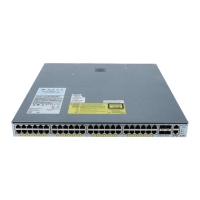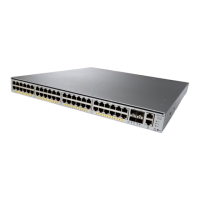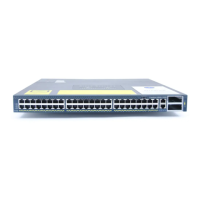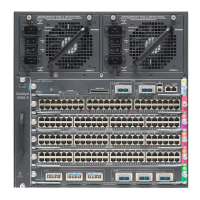Chapter 8: Configuring High Availability Features 137
Section 8-3
HSRP devices listen for hellos from the active device until a holdtime period expires.
After this, the active device is declared dead, and the next-highest-priority device
becomes active. You can adjust this to holdtime (up to 255 seconds, default 10 sec-
onds, or up to 3000 milliseconds) by using msec. Make sure the holdtime is set con-
sistently across all HSRP devices in the group.
Tip To be notified of HSRP active device changeovers, you can enable SNMP traps from
the HSRP MIB. Use the snmp-server enable traps hsrp command. See Section “12-2:
Simple Network Management Protocol” in Chapter 12, Switch Management,” for more
information about SNMP configuration.
HSRP Example
Two Layer 3 switches have interfaces on VLAN 199. These devices can be two MSFC
modules in a single Catalyst 6000 chassis or in two separate chassis, or two Catalyst 3550
switches, and so on.
Here, HSRP group 1 is used. In fact, HSRP group 1 can be used on every VLAN inter-
face, provided that no Layer 2 bridging is configured. The HSRP devices share the
192.168.104.1 IP address so that the hosts on VLAN 199 always have a default gateway
available. Note that IP address 192.168.104.1 appears as the virtual MAC address 00-00-
0C-07-AC-01 (01 signifying HSRP group 1).
The devices are set with an HSRP hello time of 3 seconds and a holdtime of 40 seconds.
Device A is configured with priority 210, making it the active device over device B’s pri-
ority of 200. Device A is configured to preempt all other lower-priority HSRP devices
that might become active but only if this is at least 60 seconds after it has been restarted.
This allows it to immediately take over its active role if needed. (This is not necessary in a
two-router HSRP scenario because the two devices always trade off the active role.
Preemption can be useful when more than two HSRP devices participate in a group.)
Finally, the HSRP devices use the string myhsrpkey in all HSRP communication as a sim-
ple form of authentication. If a host attempts to use HSRP messages without the authen-
tication key, none of the other devices listen to it.
Layer 3 Device A configuration:
(global) interface vlan 199
(interface) standby 1 ip 192.168.104.1
(interface) standby 1 priority 210 preempt delay 60
(interface) standby 1 authentication myhsrpkey
(interface) standby 1 timers 3 40
Layer 3 Device B configuration:
(global) interface vlan 199
(interface) standby 1 ip 192.168.104.1
